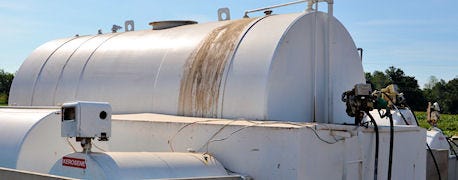September 10, 2013

You've made the switch to ultra-low-sulfur diesel fuel. And because of it, your diesel-powered tractors and trucks are burning clean fuel. But there's one change you may not have made yet regarding ULSD fuel.
ULSD fuel poses a greater static ignition hazard than earlier diesel formulations, says Gail Lapierre, AgrAbility Project outreach specialist for University of Vermont Extension. That means an increased risk of fire or explosion if your fuel supply tank, transfer pump, transfer hose, nozzle and other components aren't properly grounded and bonded.
Refineries have added a static-dissipating additive. But its effectiveness is reduced over time and by passing through filters as it makes its way to your fuel storage tank, points out Lapierre. Static charges can build up as the fuel flows though the fuel delivery system.

GOT IT GROUNDED? Today's ULSD fuel can build fuel system static charge faster than former diesel formulations. Biggest risk is for fuel tanks sitting on truck or trailer bed liners.
What's the risk
While diesel fuel isn't as combustible as gasoline, it's nearly so. When static electricity discharge occurs with combustible vapors present, a fire or explosion may result while you're fueling your vehicle or equipment.
Any fire or explosion would cause flaming fuel to come back out the filler neck onto the person fueling the equipment. This has happened, with tragic results. So make sure your entire system is properly grounded and bonded.
A properly grounded fuel delivery system has an electrically conductive connection from the fuel delivery tank system to earth ground to allow static and electrical charge dissipation.
Your vehicle, with its rubber tires, is pretty well grounded. But do you have a bed liner in your pickup truck? If yes, then that fuel tank in the truck bed isn't grounded and it needs to be bolted directly to the truck to be so.
A properly bonded fuel delivery system has an electrically conductive, unbroken connection between all components. A wire connection from the fuel delivery system to the equipment chassis equalizes the static electric potential between the two machines, reducing the chance of a static electric discharge. If you have jumper cables in your truck, they will suffice for bonding.
Stay put while refueling equipment. If you're walking around, you could be building a static charge. Touch the body of the truck to dissipate any static build-up before touching the fueling system.
If you are unsure about how well your system is grounded or have questions about bonding, contact your fuel supplier to request a check of your system. For more details, check the Association of Equipment Manufacturers' bulletin at www.aem.org/SRT/Technical/BestPracticeBulletins. They were updated in July.
You May Also Like




